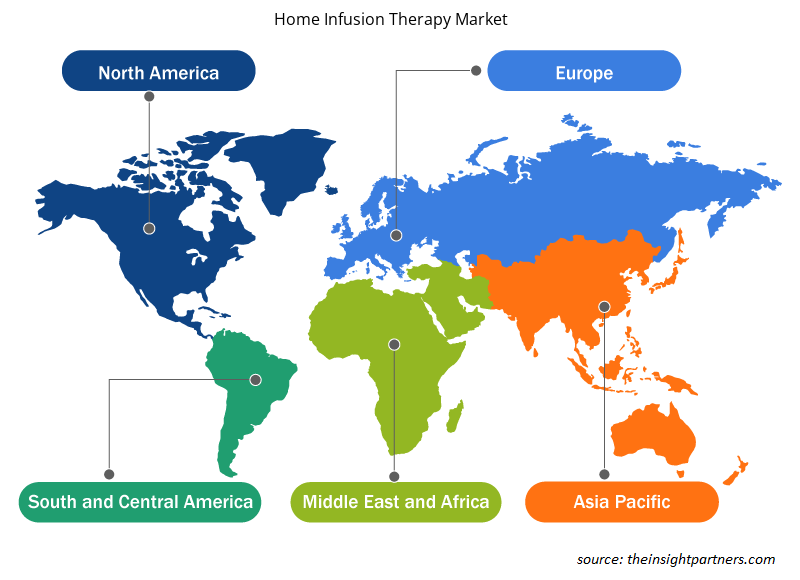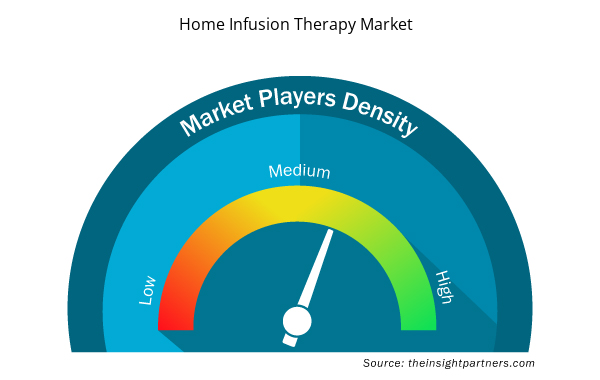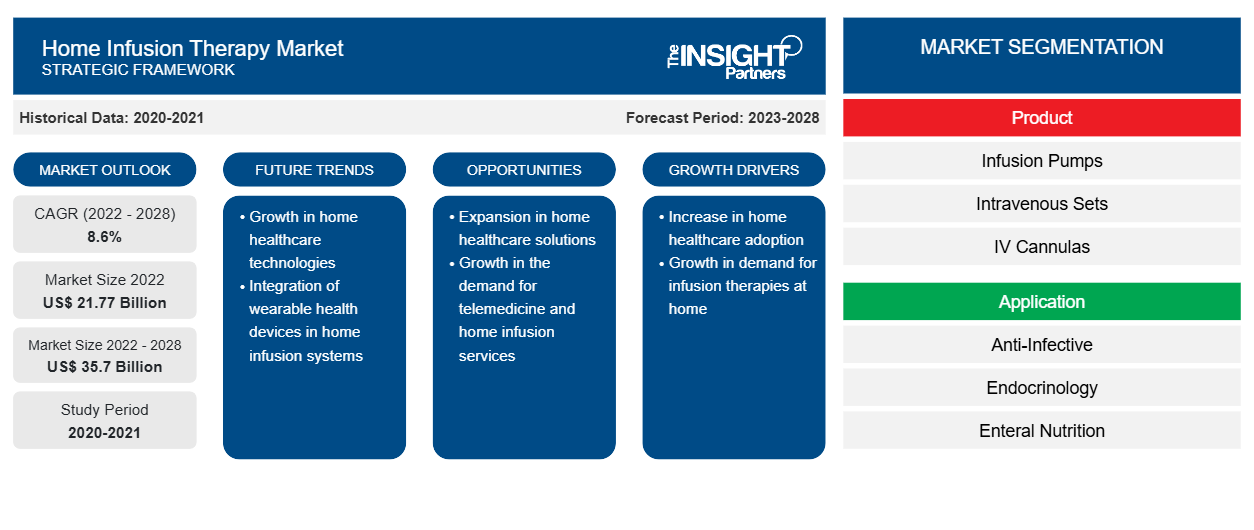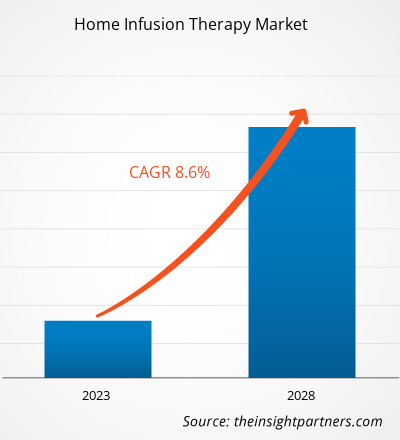[研究报告] 家庭输液治疗市场预计将从 2022 年的 217.6595 亿美元增长到 2028 年的 356.9605 亿美元;预计 2022 年至 2028 年的复合年增长率为 8.6%。
市场洞察和分析师观点:
家庭输液治疗涉及在家中对个人进行静脉或皮下药物或生物制剂注射。进行家庭输液所需的组件包括药物(抗病毒药物、免疫球蛋白)、设备(泵)和用品(管子和导管)。家庭输液过程通常需要多个实体之间的协调,包括患者、医生、医院出院规划人员、健康计划、家庭输液药房以及(如果适用)家庭健康机构。慢性病发病率的增加和老年人口的增加正在推动家庭输液治疗市场的增长。
增长动力和挑战:
心血管、营养和胃肠道疾病、类风湿性关节炎和神经系统疾病等慢性疾病影响着人们的整体生活质量。据世界卫生组织 (WHO) 估计,全球超过 50% 的人口患有至少一种慢性疾病。美国疾病控制和预防中心 (CDC) 表示,2019 年美国每 10 人中就有 6 人患有至少一种慢性疾病。根据 2021 年发布的一项大型跨国研究《功能性胃肠道疾病的全球患病率和负担,罗马基金会全球研究结果》,在接受调查的来自全球 33 个国家的 73,076 名成年人中,约 40% 患有功能性胃肠道疾病 (GFID)。与年龄相关的胃肠道问题在 64 岁及以上的老年人群体中更为常见。根据 2022 年发表的一项名为《印度成年人的胃肠道问题:印度纵向老龄化研究的证据》的研究,自述胃肠道疾病的患病率约为 18%。该研究还提到,世界各地观察到的胃肠道问题发生率各不相同,从伊朗的 14% 到一些西方国家的 54% 不等。
心血管疾病 (CVD),尤其是与忙碌生活方式相关的疾病,是全球死亡的重要原因。根据国际糖尿病联盟 (IDF) 的数据,2021 年全球 20-79 岁人群中 5.37 亿人患有糖尿病,预计到 2045 年这一数字将上升到 7.83 亿。此外,2021 年糖尿病导致全球 670 万人死亡。根据神经病学联盟的数据,2019 年登记的神经病学病例约为 1470 万例,每 6 人中至少有 1 人患有一种或多种神经病学疾病。
衰老会导致生理完整性的持续丧失,从而导致功能下降和死亡风险增加。身体功能退化是老年患者患上大多数慢性病(包括糖尿病、心血管疾病和神经系统疾病)的主要风险因素。根据《2019 年全球老龄化调查》,到 2025 年,65 岁及以上人口的比例可能会从 2019 年的每 11 人中 1 人增加到每 6 人中 1 人。根据美国人口普查局的数据,到 2060 年,65 岁及以上美国人的数量预计将从 2016 年的 4600 万增加一倍至 9800 多万,老年人口占全球人口的比例将从 15% 增加到同期的约 24%。此外,除非洲外,所有地区的老龄化速度都将很快,到 2050 年,60 岁及以上的人口将占总人口的近四分之一或更多。因此,慢性病发病率的上升,加上老年人口的不断增长,推动了家庭输液治疗市场的增长。
然而,在过去几年中,医疗机构收到了许多涉及输液泵的不良事件报告,导致产品召回。输液泵产品召回的主要原因是软件相关问题、用户界面问题以及机械和电气故障。例如,2022 年 4 月,史密斯医疗公司因软件故障召回了超过 118,000 台 Medfusion 注射器输液泵(型号 3500 和 4000),导致患者因输液不足或过量而受到严重伤害或死亡,或延迟向患者提供关键药物。它造成了大约七人重伤和一人死亡。同样,2020 年 12 月,FDA 宣布对超过 50 万台 Baxter Sigma 输液泵进行一级召回,原因是警报有缺陷,导致 3 名患者死亡和 51 人重伤。因此,与家庭输液程序和输液泵召回相关的安全问题阻碍了家庭输液治疗市场的增长。
定制此报告以满足您的需求
您可以免费定制任何报告,包括本报告的部分内容、国家级分析、Excel 数据包,以及为初创企业和大学提供优惠和折扣
- 获取此报告的关键市场趋势。这个免费样品将包括数据分析,从市场趋势到估计和预测。
报告细分和范围:
全球家庭输液治疗市场根据产品、应用、最终用户和地理位置进行细分。根据产品,家庭输液治疗市场细分为输液泵、静脉注射装置、静脉插管和无针连接器。输液泵细分市场细分为胰岛素泵、弹性泵和注射泵。根据应用,家庭输液治疗市场细分为抗感染、内分泌、肠内营养、特种药品、补液疗法、化疗和其他。根据给药途径,家庭输液治疗市场细分为肌肉注射、皮下注射和硬膜外注射。
根据地理分布,全球家庭输液治疗市场分为北美洲(美国、加拿大和墨西哥)、欧洲(德国、法国、意大利、英国、西班牙和欧洲其他地区)、亚太地区(澳大利亚、中国、日本、印度、韩国和亚太地区其他地区)、中东和非洲(南非、沙特阿拉伯、阿联酋和中东和非洲其他地区)以及南美洲和中美洲(巴西、阿根廷和南美洲和中美洲其他地区)
全球家庭输液治疗市场的细分分析:
根据产品,家庭输液治疗市场细分为输液泵、静脉注射套件、静脉插管和无针连接器。2022 年,输液泵细分市场占据最大市场份额。此外,由于输液泵被广泛用于为患者提供营养和给药,包括高风险药物,预计同一细分市场在预测期内的复合年增长率最高。输液泵细分市场的市场细分为胰岛素泵、弹性泵和注射泵。2022 年,胰岛素泵细分市场占据最大市场份额。
根据应用,家庭输液治疗市场细分为抗感染、内分泌、肠内营养、专科药物、补液疗法、化疗等。抗感染领域在 2022 年占据了最大的市场份额。内分泌领域预计将以最高的复合年增长率增长。
根据给药途径,家庭输液治疗市场分为肌肉注射、皮下注射和硬膜外注射。2022 年,肌肉注射部分占据家庭输液治疗市场的最大份额,预计也将实现最高的复合年增长率。药物起效快且无胃病等因素推动了肌肉注射部分的增长。
区域分析:
根据地域划分,全球家庭输液治疗市场分为五个主要区域:北美、欧洲、亚太、南美和中美以及中东和非洲。2022 年,北美占据全球家庭输液治疗市场规模的最大份额,预计亚太地区在预测期内的复合年增长率最高。在北美,美国是家庭输液治疗的最大市场。
预计亚太地区将占据全球家庭输液治疗市场增长最快的地区。中国在 2022 年占据最大的市场份额,预计印度将在该市场实现显著的复合年增长率。这些国家的市场增长归因于慢性病患病率的上升、老年人口的增加、家庭输液治疗提供商的存在感不断增强以及政府举措的增多。例如,中国政府已采用“健康中国 2030”计划,以促进国内医疗服务,同时为全球带来巨大利益。该国人口更容易患上传染病、慢性病和急性病。中国面临着肺癌、结直肠癌、食道癌、心脏病和糖尿病的高负担。医疗保健提供者通常建议采用静脉注射疗法和药物给药来治疗癌症、感染和其他疾病,从而推动家庭输液治疗市场的增长。
根据世界卫生组织 (WHO) 的数据,中国糖尿病患病率很高,超过 10% 的中国总人口患有糖尿病。此外,根据 WHO 的数据,到 2040 年,约有 4.02 亿人(占总人口的 28%)年龄将超过 60 岁。因此,老年人口的增加和代谢风险因素的日益普遍,正在增加全国心血管疾病和糖尿病的负担。这为在中国应用家庭输液疗法进行药物管理和静脉注射治疗带来了需求。此外,当地主要参与者的不断增加正在推动中国家庭输液治疗市场的增长。制造商正专注于扩大其战略性的全球影响力和专业知识以及独有的技术能力,从而扩大中国家庭输液治疗市场。因此,糖尿病和慢性病患病率的上升、老年人口的增加以及区域参与者数量的激增预计将推动预测期内中国家庭输液治疗市场的增长。
家庭输液治疗市场区域洞察
Insight Partners 的分析师已详细解释了预测期内影响家庭输液治疗市场的区域趋势和因素。本节还讨论了北美、欧洲、亚太地区、中东和非洲以及南美和中美洲的家庭输液治疗市场细分和地理位置。

- 获取家庭输液治疗市场的区域特定数据
家庭输液治疗市场报告范围
| 报告属性 | 细节 |
|---|---|
| 2022 年市场规模 | 217.7亿美元 |
| 2028 年市场规模 | 357亿美元 |
| 全球复合年增长率(2022 - 2028) | 8.6% |
| 史料 | 2020-2021 |
| 预测期 | 2023-2028 |
| 涵盖的领域 | 按产品
|
| 覆盖地区和国家 | 北美
|
| 市场领导者和主要公司简介 |
|
家庭输液治疗市场参与者密度:了解其对业务动态的影响
家庭输液治疗市场正在快速增长,这得益于终端用户需求的不断增长,而这些需求又源于消费者偏好的不断变化、技术进步以及对产品优势的认识不断提高等因素。随着需求的增加,企业正在扩大其产品范围,进行创新以满足消费者的需求,并利用新兴趋势,从而进一步推动市场增长。
市场参与者密度是指在特定市场或行业内运营的企业或公司的分布情况。它表明相对于给定市场空间的规模或总市场价值,有多少竞争对手(市场参与者)存在于该市场空间中。
在家庭输液治疗市场运营的主要公司有:
- B. Braun Melsungen AG
- 麦克雷尔医疗设备公司
- 百特国际公司
- 尼普洛公司
- 碧迪公司
免责声明:上面列出的公司没有按照任何特定顺序排列。

- 获取家庭输液治疗市场顶级关键参与者概览
行业发展和未来机遇:
以下列出了全球家庭输液治疗市场的主要参与者采取的各种举措:
- 2023 年 1 月,Eitan Medical 宣布在公司总部开设新的制造工厂。现场制造将支持 Eitan Medical 制药解决方案部门的生产规模。该工厂将生产多种设备配置的 Sorrel 可穿戴药物输送平台,包括 Sorrel 小瓶和药筒式可穿戴注射器、预装和预装在最大 50 毫升的初级容器中,以及小容量随身注射器。
- 2022 年 5 月,费森尤斯卡比完成了对输液系统制造商 Ivenix 的收购。费森尤斯卡比目前为美国医疗保健专业人士提供广泛且不断扩展的先进输液泵和解决方案组合,以满足整个护理过程中的需求。
- 2022 年 1 月,ICU Medical Inc 宣布已完成从 Smiths Group plc 收购 Smiths Medical。Smiths Medical 业务包括注射器和门诊输液设备、血管通路和重要护理产品。与 ICU Medical 现有业务相结合后,合并后的公司将创建一家领先的输液治疗公司,预计合并收入约为 25 亿美元。
- 2021 年 6 月,麦克雷尔医疗设备公司宣布扩大其全球影响力,宣布与百特在澳大利亚和新西兰建立新的分销合作伙伴关系,共同销售用于家庭肠外营养的 Rythmic PN+ 移动输液泵。
- 2021 年 6 月,Micrel Medical 和 Baxter Healthcare(Baxter)宣布达成协议,分销用于肠外营养 (PN) 的 Micrel Mini Rythmic PN+ 输液泵。Micrel Mini Rythmic PN+ 是一款支持住院患者肠外营养的便携式输液泵。作为协议的一部分,Baxter Healthcare 将成为 ANZ 地区 Micrel Mini Rythmic PN+ 输液泵及其配件的独家经销商。
竞争格局和重点公司:
全球家庭输液治疗市场有多家知名企业。一些顶级家庭输液公司包括 B. Braun Melsungen AG、Micrel Medical Devices SA、Baxter International Inc、Nipro Corp、Becton Dickinson and Co、Fresenius Kabi AG、ICU Medical Inc、JMS Co Ltd、Eitan Medical Ltd 和 Terumo Corp 等。这些公司专注于各种新产品开发和地域扩张。这有助于他们满足全球日益增长的消费者需求,并扩大其专业产品组合的产品范围。他们拥有广泛的全球影响力,因此能够为大量客户提供服务。此外,这也为他们提供了增加市场份额的机会。
- 历史分析(2 年)、基准年、预测(7 年)及复合年增长率
- PEST 和 SWOT 分析
- 市场规模价值/数量 - 全球、区域、国家
- 行业和竞争格局
- Excel 数据集


- Semiconductor Metrology and Inspection Market
- Trade Promotion Management Software Market
- Dealer Management System Market
- Machine Condition Monitoring Market
- Batter and Breader Premixes Market
- Animal Genetics Market
- Nitrogenous Fertilizer Market
- Precast Concrete Market
- Hot Melt Adhesives Market
- Clinical Trial Supplies Market

Report Coverage
Revenue forecast, Company Analysis, Industry landscape, Growth factors, and Trends

Segment Covered
This text is related
to segments covered.

Regional Scope
North America, Europe, Asia Pacific, Middle East & Africa, South & Central America

Country Scope
This text is related
to country scope.
常见问题
Companies operating in the market are B. Braun Melsungen AG, Micrel Medical Devices SA, Baxter International Inc, Nipro Corp, Becton Dickinson and Co, Fresenius Kabi AG, ICU Medical Inc, JMS Co Ltd, Eitan Medical Ltd, and Terumo Corp.
Global home infusion therapy market is segmented by region into North America, Europe, Asia Pacific, the Middle East & Africa, and South & Central America. North America is likely to continue its dominance in the home infusion therapy market during 2022–2028. The US holds the largest share of the market in North America and is expected to continue this trend during the forecast period.
Based on application, the home infusion therapy market is segmented into enteral nutrition, anti-infective, endocrinology, hydration therapy, chemotherapy, specialty pharmaceuticals, and others. The anti-infective segment held the largest share of the market in 2021. The endocrinology segment is expected to record the highest CAGR during the forecast period.
Home infusion therapy involves the intravenous or subcutaneous administration of drugs or biologicals to an individual at home. The components needed to perform home infusion include the drug (antivirals, immune globulin), equipment (a pump), and supplies (tubing and catheters). The home infusion process typically requires coordination among multiple entities, including patients, physicians, hospital discharge planners, health plans, home infusion pharmacies, and, if applicable, home health agencies.
Based on product, the home infusion therapy market is segmented into infusion pump, intravenous sets, IV cannulas, and needleless connectors. The market for the infusion pumps segment is subsegmented into insulin pumps, elastomeric pumps, syringe pumps, and others. The infusion pumps segment held the largest market share in 2021 and is anticipated to register the highest CAGR during the forecast period.
Key factors driving the market growth are increasing incidences of chronic disorders coupled with rising geriatric population and reduction in duration of hospital stays and surge in cost of care.
Trends and growth analysis reports related to Life Sciences : READ MORE..
The List of Companies - Home Infusion Therapy Market:
- B. Braun Melsungen AG
- Micrel Medical Devices SA
- Baxter International Inc
- Nipro Corp
- Becton Dickinson and Co
- Fresenius Kabi AG
- ICU Medical Inc
- JMS Co Ltd
- Eitan Medical Ltd
- Terumo Corp
The Insight Partners performs research in 4 major stages: Data Collection & Secondary Research, Primary Research, Data Analysis and Data Triangulation & Final Review.
- Data Collection and Secondary Research:
As a market research and consulting firm operating from a decade, we have published and advised several client across the globe. First step for any study will start with an assessment of currently available data and insights from existing reports. Further, historical and current market information is collected from Investor Presentations, Annual Reports, SEC Filings, etc., and other information related to company’s performance and market positioning are gathered from Paid Databases (Factiva, Hoovers, and Reuters) and various other publications available in public domain.
Several associations trade associates, technical forums, institutes, societies and organization are accessed to gain technical as well as market related insights through their publications such as research papers, blogs and press releases related to the studies are referred to get cues about the market. Further, white papers, journals, magazines, and other news articles published in last 3 years are scrutinized and analyzed to understand the current market trends.
- Primary Research:
The primarily interview analysis comprise of data obtained from industry participants interview and answers to survey questions gathered by in-house primary team.
For primary research, interviews are conducted with industry experts/CEOs/Marketing Managers/VPs/Subject Matter Experts from both demand and supply side to get a 360-degree view of the market. The primary team conducts several interviews based on the complexity of the markets to understand the various market trends and dynamics which makes research more credible and precise.
A typical research interview fulfils the following functions:
- Provides first-hand information on the market size, market trends, growth trends, competitive landscape, and outlook
- Validates and strengthens in-house secondary research findings
- Develops the analysis team’s expertise and market understanding
Primary research involves email interactions and telephone interviews for each market, category, segment, and sub-segment across geographies. The participants who typically take part in such a process include, but are not limited to:
- Industry participants: VPs, business development managers, market intelligence managers and national sales managers
- Outside experts: Valuation experts, research analysts and key opinion leaders specializing in the electronics and semiconductor industry.
Below is the breakup of our primary respondents by company, designation, and region:

Once we receive the confirmation from primary research sources or primary respondents, we finalize the base year market estimation and forecast the data as per the macroeconomic and microeconomic factors assessed during data collection.
- Data Analysis:
Once data is validated through both secondary as well as primary respondents, we finalize the market estimations by hypothesis formulation and factor analysis at regional and country level.
- Macro-Economic Factor Analysis:
We analyse macroeconomic indicators such the gross domestic product (GDP), increase in the demand for goods and services across industries, technological advancement, regional economic growth, governmental policies, the influence of COVID-19, PEST analysis, and other aspects. This analysis aids in setting benchmarks for various nations/regions and approximating market splits. Additionally, the general trend of the aforementioned components aid in determining the market's development possibilities.
- Country Level Data:
Various factors that are especially aligned to the country are taken into account to determine the market size for a certain area and country, including the presence of vendors, such as headquarters and offices, the country's GDP, demand patterns, and industry growth. To comprehend the market dynamics for the nation, a number of growth variables, inhibitors, application areas, and current market trends are researched. The aforementioned elements aid in determining the country's overall market's growth potential.
- Company Profile:
The “Table of Contents” is formulated by listing and analyzing more than 25 - 30 companies operating in the market ecosystem across geographies. However, we profile only 10 companies as a standard practice in our syndicate reports. These 10 companies comprise leading, emerging, and regional players. Nonetheless, our analysis is not restricted to the 10 listed companies, we also analyze other companies present in the market to develop a holistic view and understand the prevailing trends. The “Company Profiles” section in the report covers key facts, business description, products & services, financial information, SWOT analysis, and key developments. The financial information presented is extracted from the annual reports and official documents of the publicly listed companies. Upon collecting the information for the sections of respective companies, we verify them via various primary sources and then compile the data in respective company profiles. The company level information helps us in deriving the base number as well as in forecasting the market size.
- Developing Base Number:
Aggregation of sales statistics (2020-2022) and macro-economic factor, and other secondary and primary research insights are utilized to arrive at base number and related market shares for 2022. The data gaps are identified in this step and relevant market data is analyzed, collected from paid primary interviews or databases. On finalizing the base year market size, forecasts are developed on the basis of macro-economic, industry and market growth factors and company level analysis.
- Data Triangulation and Final Review:
The market findings and base year market size calculations are validated from supply as well as demand side. Demand side validations are based on macro-economic factor analysis and benchmarks for respective regions and countries. In case of supply side validations, revenues of major companies are estimated (in case not available) based on industry benchmark, approximate number of employees, product portfolio, and primary interviews revenues are gathered. Further revenue from target product/service segment is assessed to avoid overshooting of market statistics. In case of heavy deviations between supply and demand side values, all thes steps are repeated to achieve synchronization.
We follow an iterative model, wherein we share our research findings with Subject Matter Experts (SME’s) and Key Opinion Leaders (KOLs) until consensus view of the market is not formulated – this model negates any drastic deviation in the opinions of experts. Only validated and universally acceptable research findings are quoted in our reports.
We have important check points that we use to validate our research findings – which we call – data triangulation, where we validate the information, we generate from secondary sources with primary interviews and then we re-validate with our internal data bases and Subject matter experts. This comprehensive model enables us to deliver high quality, reliable data in shortest possible time.


 获取此报告的免费样本
获取此报告的免费样本